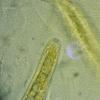
21-11-2025 10:56
 Christopher Engelhardt
Christopher Engelhardt
Very small (~0,5 mm) white ascos, found yesterday

14-11-2025 16:26
 Marian Jagers
Marian Jagers
Hello everyone, On dead wood of Cytisus scoparius

17-11-2025 21:46
Philippe PELLICIERBonjour,Récolté sur bois pourrissant de feuillu

20-11-2025 14:14
Mick PeerdemanFound on the leaves of 'Juglans regia' in the Neth

20-11-2025 13:07
Mick PeerdemanIn January i found these black markings on the dea

20-11-2025 12:38
Mick PeerdemanDear all,Last week i stumbled upon a leaf of ilex

19-11-2025 23:21
 carl van den broeck
carl van den broeck
Dear guestIn Waardamme, Belgium, I found dozens of
Ceratosphaeria lampadophora vs. C. mycophila
Edvin Johannesen,
08-04-2025 17:31
 I have a fresh specimen of a Ceratosphaeria on dead wood (Populus tremula). The spores measure (40-) 45 (-50) x 5 µm og asci (170-) 175 (-177) x 10-11 µm in water. I find conflicting measures for C. lampadophora in the literature. Does anyone have the correct measures for these two species? Are there other distinguishing characters that separate these two species?
I have a fresh specimen of a Ceratosphaeria on dead wood (Populus tremula). The spores measure (40-) 45 (-50) x 5 µm og asci (170-) 175 (-177) x 10-11 µm in water. I find conflicting measures for C. lampadophora in the literature. Does anyone have the correct measures for these two species? Are there other distinguishing characters that separate these two species?I have photos if necessary. Thanks!
Bernard Declercq,
08-04-2025 20:04

Re : Ceratosphaeria lampadophora vs. C. mycophila
Hi Edvin,
C. lampadospora is a well known (holotype) and sequenced species, see Crous et al. (2020: 87).
Macroscopy:
C. lampadospora has perithecia with a neck several times longer than its diameter, while in C. mycophila the neck is about half as long as the diameter.
Microscopy:
C. lampadospora has ascospores longer than 50 µm in average, while up to 50 µm long in C. mycophila. Septation similar (7-9-septa), although Saccardo (1883) and Berlese (1894) observed additional septa in C. lampadospora.
Habitat/substrate:
C. lampadospora occurs on rotten wood. Populus is a typical substrate. May be aquatic.
C. mycophila is fungicolous (always?)
Al the best,
Bernard
C. lampadospora is a well known (holotype) and sequenced species, see Crous et al. (2020: 87).
Macroscopy:
C. lampadospora has perithecia with a neck several times longer than its diameter, while in C. mycophila the neck is about half as long as the diameter.
Microscopy:
C. lampadospora has ascospores longer than 50 µm in average, while up to 50 µm long in C. mycophila. Septation similar (7-9-septa), although Saccardo (1883) and Berlese (1894) observed additional septa in C. lampadospora.
Habitat/substrate:
C. lampadospora occurs on rotten wood. Populus is a typical substrate. May be aquatic.
C. mycophila is fungicolous (always?)
Al the best,
Bernard
Edvin Johannesen,
08-04-2025 22:39

Re : Ceratosphaeria lampadophora vs. C. mycophila
Thank you, Bernard! The spores fit C. mycophila best and the ostiolar neck is also quite short. It seems, however, that it is not associated with a fungus, at least not a fruiting body, but of course there is always mycelium of some sort in dead wood.
I can post some photos tomorrow.
Best regards,
Edvin
I can post some photos tomorrow.
Best regards,
Edvin
Edvin Johannesen,
09-04-2025 14:24
Bernard Declercq,
10-04-2025 10:54

Re : Ceratosphaeria lampadophora vs. C. mycophila
C. mycophila maybe. Anyhow Ceratosphaeria lampadophora to be excluded.
Bernard
Bernard
Edvin Johannesen,
10-04-2025 11:05

Re : Ceratosphaeria lampadophora vs. C. mycophila
Thanks!






